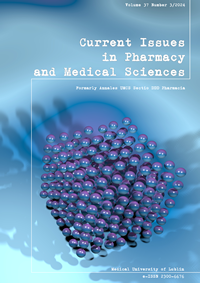Sternalis muscle, a rare anatomical variation with clinical implications
DOI:
https://doi.org/10.2478/cipms-2024-0029Keywords:
ancestral development, anterior chest wall musculature, panniculus carnosusAbstract
The sternalis muscle is a rare variant of the anterior chest wall musculature. Although its frequency in general population worldwide has been reported from 2% to 8%, its prevalence depends on regions and populations. The aim of this paper is to describe one of the first cases of sternalis muscle found in Central Europe. An anterior chest wall of 64-year-old white male was dissected during a regular anatomy class at Department of Human Anatomy. A right unilateral sternalis muscle was revealed and described.
The unilateral sternalis muscle laid between the pectoral and the superficial thoracic fascia. The muscle was long and wide. In addition, it had a massive tendon. According to the Snosek et al. Classification, it was a “simple unilateral” type. This report presents another case of the sternalis muscle among humans. Although the sternalis muscle serves a minor role in body movement, its occurrence gives several clinical implications. The awareness of variability in the thoracic region is important during diagnostic and treatment processes or in surgical operation planning.
References
1. Ge Z, Tong Y, Zhu S, Fang X, Zhuo L, Gong X. Prevalence and variance of the sternalis muscle: a study in the Chinese population using multi-detector CT.Surg Radiol Anat.2014;36:219-24.
2. Jelev L, Georgiev G, Surchev L. The sternalis muscle in the Bulgarian population: classification of sternales.J Anat.2001;199:359-63.
3. Snosek M, Tubbs RS, Loukas M. Sternalis muscle, what every anatomist and clinician should know.Clin Anat.2014;27:866-84.
4. Awad KA, Ahmed GE, A Llah QAA, Ahmed HA. Bilateral sternalis muscle in a Sudanese cadaver.Int J Surg Case Rep.2021;89:106511.
5. Sarikçioglu L. Three sternalis muscles associated with abnormal attachments of the pectoralis major muscle.Int J Exp Clin Anat.2008;2:67-71.
6. Naldaiz-Gastesi N, Bahri OA, López de Munain A, McCullagh KJA, Izeta A. The panniculus carnosus muscle: an evolutionary enigma at the intersection of distinct research fields.J Anat.2018;233(3):275-88.
7. Sonne JWH. Prevalence of the sternalis muscle in a sample of routinely dissected human cadavers.Surg Radiol Anat.2020;42: 87-90.
8. Slater J, McLean NR, Youssef M, Bristow G. Bilateral musculus sternalis – An anatomical and clinical review.Surgeon.2022;20:378-81.
9. Gruber L, Martinoli C, Tagliafico AS, Gruber J, Klauser AS. A rare case of a symptomatic sternalis muscle: Ultrasonograpy and MRI correlation.Ultrasound Int Open.2016;2(4):140-1.
10. Demirpolat G, Oktay A, Bilgen I, Isayev H. Mammographic features of the sternalis muscle.Diagn Interv Radiol.2010;16(4):276-8.
11. Duque-Parra JE, Barco-Ríos J, Vélez-García JF. Incidence of sternalis muscle in the caldas population (Colombia): Anatomical variations.Int J Morphol.2019;37(4):1342-6.
12. Haładaj R, Wysiadecki G, Clarke E, Polguj M, Topol M. Anatomical variations of the pectoralis major muscle: Notes on their impact on pectoral nerve innervation patterns and discussion on their clinical relevance.Biomed Res Int.2019;2019:6212039.
13. Raikos A, Paraskevas GK, Yusuf F, Kordali P, Ioannidis O, Brand-Saberi B. Sternalis muscle: a new crossed subtype, classification, and surgical applications.Ann Plast Surg.2011;67:646-8.
14. Katara P, Chauhan S, Arora R, Saini P. A unilateral rectus sternalis muscle: rare but normal anatomical variant of anterior chest wall musculature.J Clin Diagn Res.2013;7:2665-7.
15. Kida MY, Kudoh H. Innervation of the sternalis muscle accompanied by congenital partial absence of the pectoralis major muscle.Okajimas Folia Anat Jpn.1991;67(6):449-55.
16. Shinohara H. A warning against revival of the classic tenets of gross anatomy related to nerve-muscle specificity.J Anat.1996;188:247-8.
17. Prall CR, Azzouz L, Connolly C, Gutierrez M, Moreno N, Olumolade O, et al. Describing the sternalis muscle: a new variant and an amended classification.Surg Radiol Anat.2019;41:243-5.
Downloads
Published
Issue
Section
License
Copyright (c) 2024 Authors

This work is licensed under a Creative Commons Attribution-NonCommercial-NoDerivatives 3.0 Unported License.


